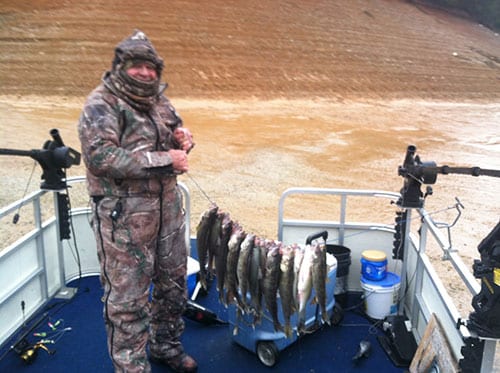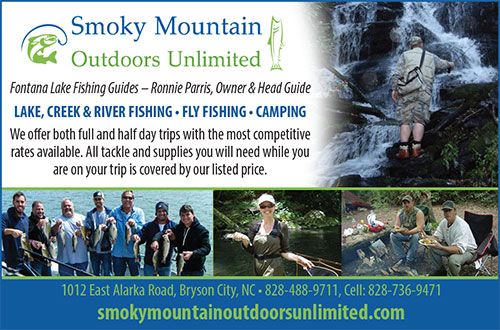February is a time of change in mountain lakes. So if you want to be successful, and come home with a good catch for the frying pan, you better be ready to change your fishing style and location to what fish want. I fish all of our mountain lakes but Fontana is my closest, and home lake, so to speak. I constantly hear folks in the local bait shops talk about how they have shut down in February as the water is at its coldest. Fish are like people in that they can’t completely stop eating, or they will die. The coldwater temps may move fish from your normal spots, where you were catching good numbers and sizes. First thing I do is start looking for warmer water; even a 2-degree change will sometimes concentrate fish in a small area. Check where streams or run off enters your lake, sometimes it‘s shallow flats or logs laying half submerged, that will give you that small temperature change that will hold fish and bait. The sunny side of the lake will always be more productive this time of year.
Some fish, such as walleye an crappie, have spawning on there minds and will be making their way up river runs to head waters and shallow spawning grounds.
These fish will sometimes hold when they hit a water column with desirable temperatures for them and the shad they feed on. If you’re lucky enough to find this, you’re in for some fast action. I like to troll and am capable of running 10 rods at once, but when I hit fish schooled like this, I’ve found it’s better to run no more than 4 rods, as the school is usually tight and in running fewer rods, I can get back in them after hooking fish. A lot of these, especially walleye, will be deep water-sometimes 80 or 90 feet, so when you get your limit, please stop fishing for them as when they are brought up from those depths, their swim bladder blows and their chance of survival when released is very low. I’ve heard people talk of venting them but I’m skeptical about the fish’s survival when this has been done. Sometimes, even after finding these fish, they are so cold they just don’t bite well trolling or even casting artificial lures to them. When I find they aren’t wanting to chase, I throw live minnows or a scented artificial, such as a tube, Fluke, or Shaky head worm. There are several different baits you can use, but the common thread is, you have to work it super slow, they want to watch it and come up and sort of “smell” it and even then, don’t expect viscous hits, as it will be a subtle take. Sometimes, you just feel the rod load.
Safety should be a main concern at this time of the year, a fall in the water is no big deal in July but do it now and you may not make it back home to your family. Also, a trip without proper clothes and you’re looking at a short, miserable trip. I like to dress in layers so I can stay warm and not be hot if it does warm up at midday. Another concern this time of year is your tackle and boat, and how it responds to the cold. Always leave your motor down till all the water drains out when you pull out so the water pump isn’t frozen the next morning. Also dry any water on the steering arm and keep a good grease in it, or your steering may be frozen. I have had the trolling motor freeze so it wouldn’t drop into the water when I got to my spot and had to keep pouring water over it to thaw it. I keep a Kerosene heater in my boat this time of year, but I would advise you to use a lot of caution when taking a heater on a boat because if you have a fire you’re trapped there with it. I usually close with the phrase take a kid fishing but if temps are too cold you may want to leave them at home as you don’t want to make it a bad experience for them. So, I’ll just close by saying, ”Be safe and good fishing“. Anyone one who would like to go out at this time can contact me at 828-488-9711
Ronnie Parris is the Owner and Head Guide of Smoky Mountain Outdoors Unlimited-Fontana Lake Fishing Guides, headquartered in Bryson City, North Carolina, heart of the Great Smoky Mountains. (www.smokymountainoutdoorsunlimited.com)

